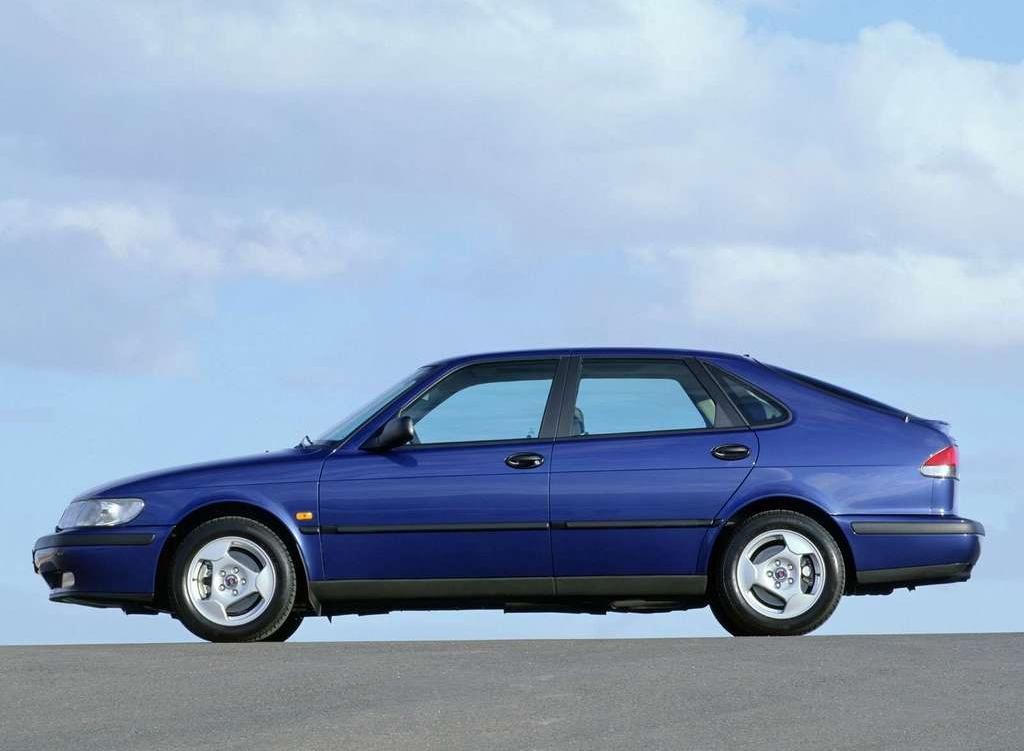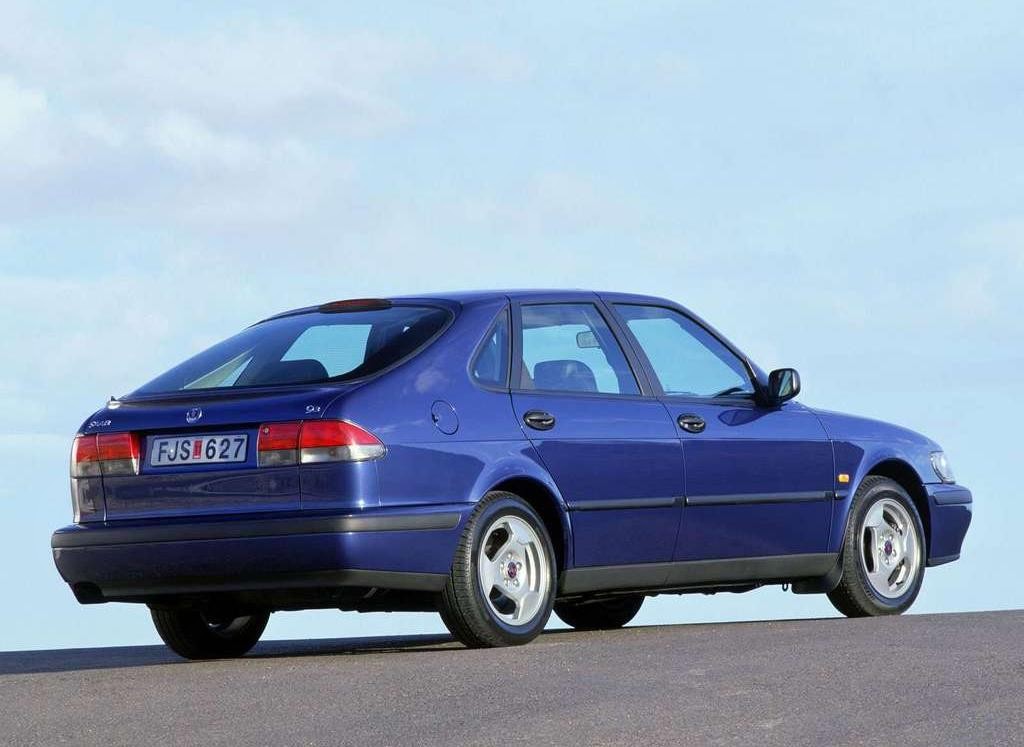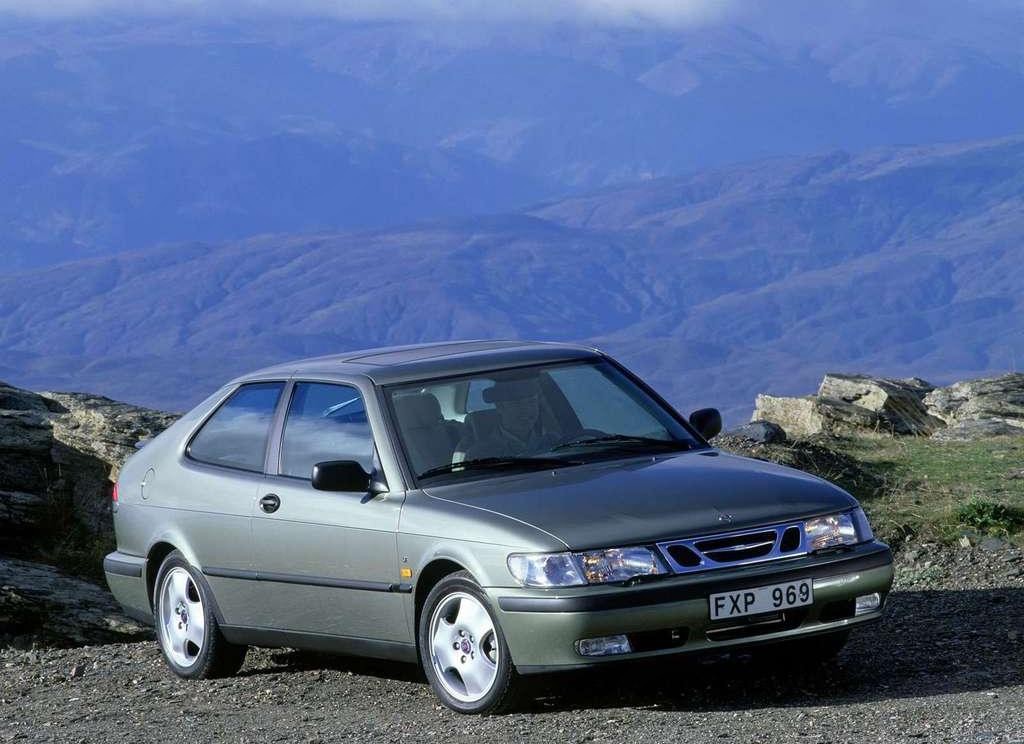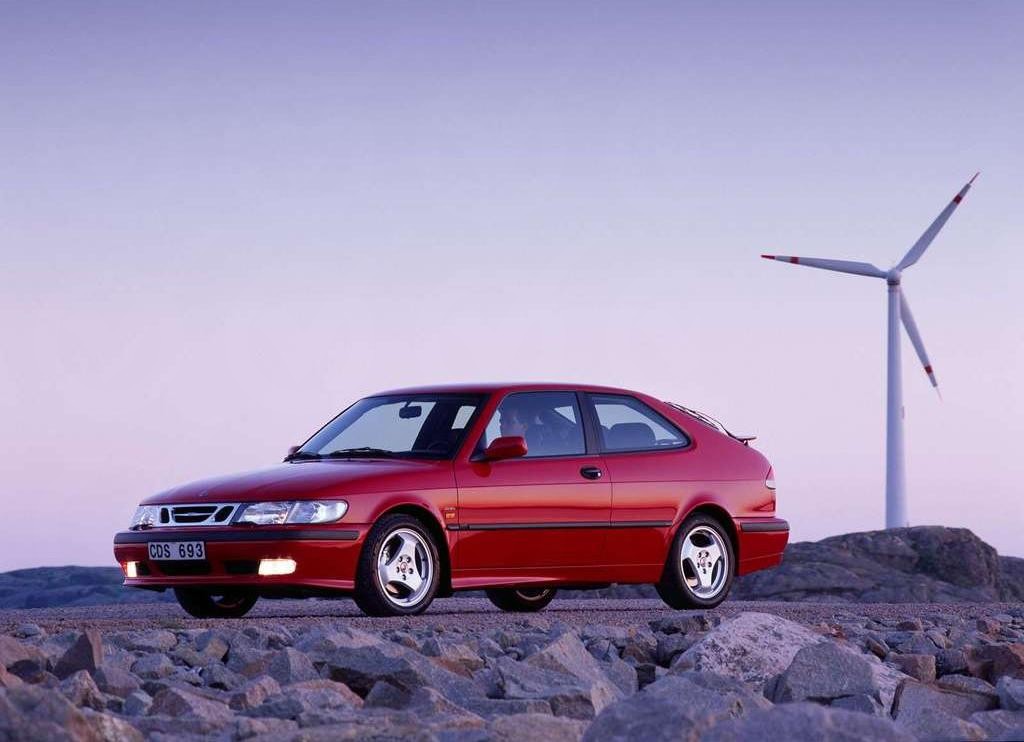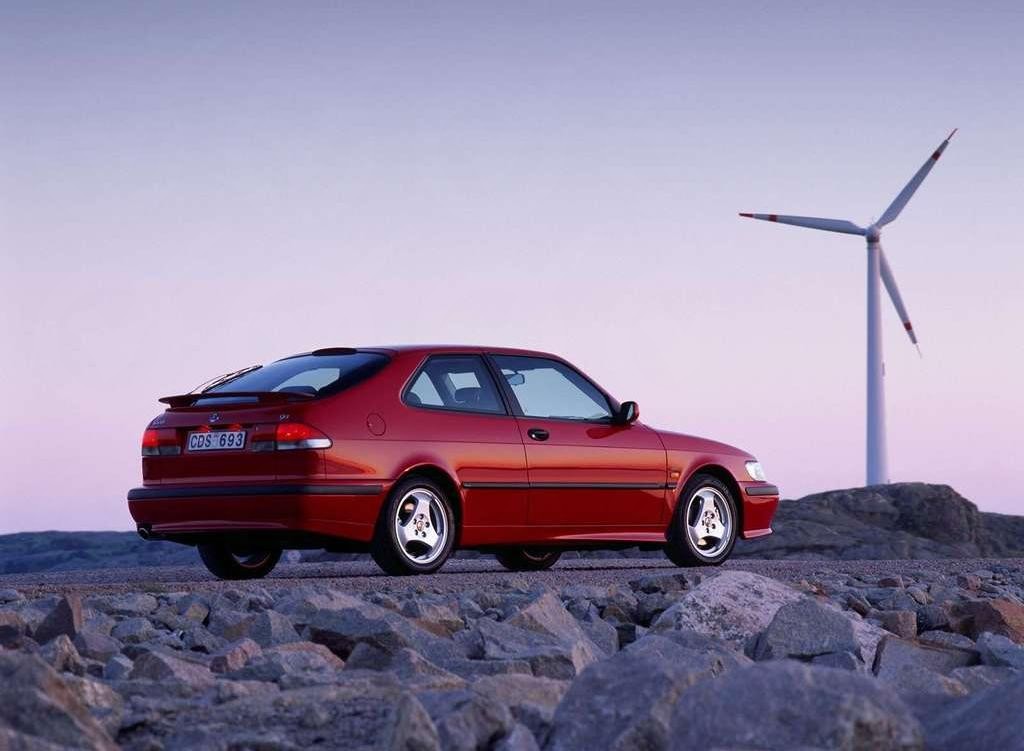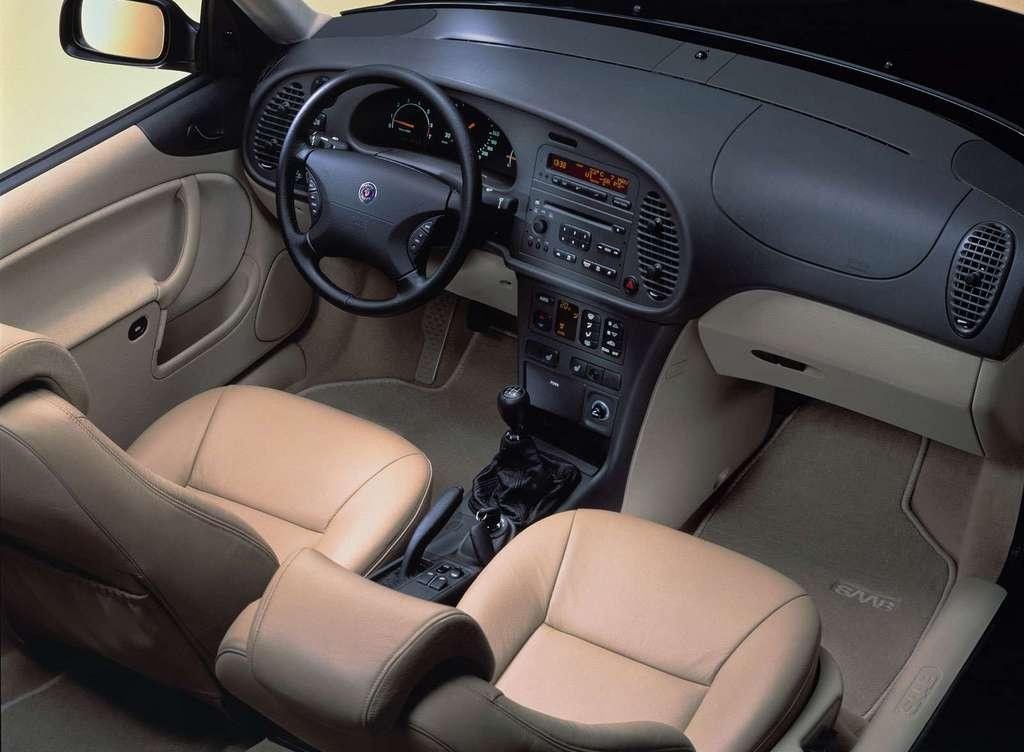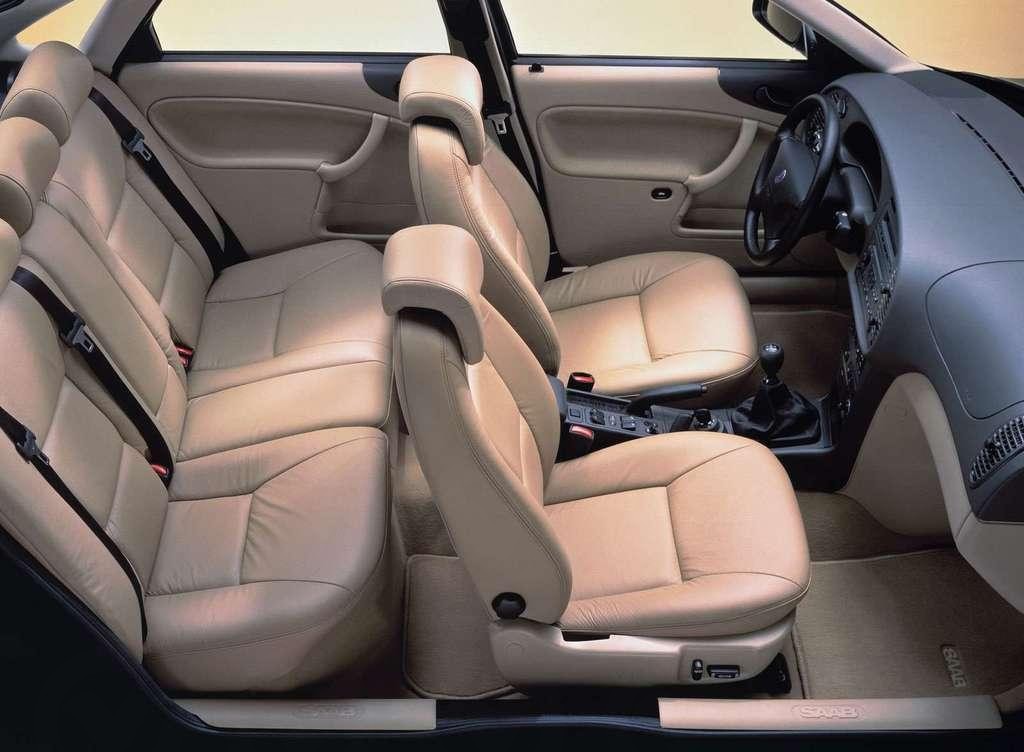
- Responsive low-pressure turbo engines
- 9-3 Aero is impressively quick
- Competent ride/handling balance
- Light, accurate steering
- Large cargo area
- Steering wheel kickback over bumps
- For 9-3 Viggen, overwhelming torque steer
- For manual models, cramped driver’s footwell
- Poor rear visibility
Overview
Released in June 1998, the Saab Mk.1 9-3 was available as a three- or five-door liftback. Manufactured in Trollhattan, Sweden, the front-wheel drive 9-3 range initially consisted of naturally aspirated and turbocharged four-cylinder engines with the 2.0, 2.3, 2.0t and 2.0T variants (see table below). In December 1998, however, the 2.0 and 2.3 variants were discontinued, leaving an all turbocharged line-up. Beyond the engine-based variants, the 9-3 range consisted of S and SE editions. In 1999, the range was expanded with the introduction of TS, Viggen (manufactured in Uusikaupunki, Finland) and limited-run Monte Carlo editions. In 2000, the SE was replaced by the Aero edition.
Engines
The 9-3 engines were from Saab’s ‘H’ engine family and all had cast iron blocks, aluminium alloy cylinder heads, double overhead camshafts and four valves per cylinder. However,
- For the 2.0 variants, the B204i engine had a compression ratio of 10.1:1;
- For the 2.3 variants, the B234i engine had a compression ratio of 10.0:1;
- For the 2.0t variants, the B204E engine was initially used – it was fitted with a Mitsubishi TD04 turbocharger which provided peak boost pressure of 0.40 bar and the engine had a compression ratio of 9.2:1. For 2001, however, the B204E was replaced by the B205E engine which was also fitted with the Mitsubishi TD04 turbocharger, but had modified Trionic engine management system and Nimonic (nickel alloy) exhaust valves;
- For 2.0T variants, the B204L which was initially used – it had a Garrett GT17 turbocharger which provided peak boost pressure of 0.40 bar and the compression ratio was 9.2:1.
- For the 2.0T Aero, however, the B205R engine was used – it had a Mitsubishi TD04-15T turbocharger which provided peak boost pressure of 1.00 bar, though its compression ratio was also 9.2:1; and,
- For the 2.3T Viggen, the B235R engine was fitted with the TD04-15T turbocharger, but with maximum boost pressure increased to 1.08 bar and the compression ratio at 9.25:1.
Transmission options consisted of five-speed manual and four-speed automatic units.
Dimensions and suspension
Compared to the Saab Mk.2 900 which it replaced, the Mk.1 9-3 was 8 mm shorter (at 4629 mm), the same width (1711 mm), 8 mm lower (1428 mm) and had a 5 mm longer wheelbase (2605 mm). Furthermore, the 9-3 had MacPherson strut front suspension and torsion beam rear suspension.
2001 update
The 9-3 was updated for 2001 and these models could be identified by their clear side indicator lenses, ‘shark fin’ telephone antennae and new ‘Saab’ badges. Inside, there were also Isofix child-seat mounting points for the back seats.
| Variant | Engine | Edition | Body | Years | Trans. | Peak power | Peak torque |
|---|---|---|---|---|---|---|---|
| 2.0 | 2.0-litre petrol I4 | S | 5dr | 1998 | 5sp man., 4sp auto |
96 kW at 6100 rpm | 177 Nm at 4300 rpm |
| 2.3 | 2.3-litre petrol I4 | S | 3dr, 5dr |
1998 | 5sp man., 4sp auto |
110kw at 5700 rpm | 210 Nm at 4300 rpm |
| 2.0t | 2.0-litre turbo petrol I4 | S | 3dr, 5dr |
1998-00 | 5sp man., 4sp auto |
113 kW at 5500 rpm | 219 Nm at 3600 rpm |
| TS | 3dr | 1999-00 | 5sp man., 4sp auto |
113 kW at 5500 rpm | 219 Nm at 3600 rpm | ||
| 2.0-litre turbo petrol I4 (Gen IV) | S | 3dr, 5dr |
2001 | 5sp man., 4sp auto |
110 kW at 5500 rpm | 240 Nm at 1800-3500 rpm | |
| Anniversary | 3dr, 5dr |
2001-02 | 5sp man., 4sp auto |
110 kW at 5500 rpm | 240 Nm at 1800-3500 rpm | ||
| 2.0T | 2.0-litre turbo petrol I4 | SE | 5dr | 1998-99 | 5sp man. | 136 kW at 5750 rpm | 263 Nm at 2100 rpm |
| 4sp auto | 136 kW at 5750 rpm | 230 Nm at 2000-5500 rpm | |||||
| Monte Carlo | 3dr, 5dr |
1999 | 5sp man. | 147 kW at 5500 rpm | 283 Nm at 2300-4800 rpm | ||
| 4sp auto | 136 kW at 5750 rpm | 230 Nm at 2000-5000 rpm | |||||
| Aero | 3dr, 5dr |
2000-02 | 5sp man. | 151 kW at 5500 rpm | 280 Nm at 2200-4600 rpm | ||
| 4sp auto | 151 kW at 5500 rpm | 250 Nm at 1900-5750 rpm | |||||
| 2.3T | 2.3-litre turbo petrol I4 | Viggen | 3dr, 5dr |
1999-00 | 5sp man. | 165 kW at 5500 rpm | 342 Nm at 2500-4000 rpm |
| 2000-01 | 5sp man. | 169 kW at 5500 rpm | 350 Nm at 2500 rpm |
Safety equipment
Standard safety equipment for the 9-3 included dual front airbags, front seat-mounted head/thorax side airbags, ABS, electronic brake force distribution, active front seat head restraints and front seatbelt pretensioners.
From 2001, the 9-3 Aero was fitted with traction control.
Euro NCAP crash testing
In Euro NCAP crash testing , a five-door 9-3 liftback – fitted with a 2.0-litre engine – received a four star adult occupant protection rating with a score of 26. In the frontal offset impact test, there was a high risk of severe chest injury and the passenger cell started to fail along the roof and upper door load paths. In the side impact test, maximum points were awarded; in the more sever pole test, the side airbags also provided a cushion between the head and the pole.
Features
Standard features for the 9-3 S included a four speaker sound system with CD player, air conditioning, cruise control, front fog lights, 60/40 split and folding rear seats, steering wheel audio controls, remote central locking, power windows and mirrors, a height adjustable steering wheel and an immobiliser.
The 9-3 TS was further equipped with 16-inch ‘Viking’ alloy wheels and a body kit which included a body-coloured front spoiler, side skirts, extended rear bumper and mirrors, and a black bootlid spoiler.
Compared to the S editions, the 9-3 SE featured 16-inch alloy wheels, a six speaker sound system with a six-disc CD changer, leather seats, a leather-wrapped steering wheel, woodgrain interior trim and a rear spoiler.
For 2001, standard features were extended to include alloy wheels (15-inch alloys for the S editions), leather seats, a leather-wrapped steering wheel, a leather gear selector and the Saab Car Computer (a multi-function trip computer).
Saab 9-3 Aero
The 9-3 Aero replaced the SE editions when it was released in February 2000. Compared to the SE, the Aero was further equipped with climate control air conditioning, contoured sports seats, power adjustable front seats and driver’s seat memory settings; the Aero was also fitted with firmer dampers and an Aero body package including a lower front spoiler, side skirts, extended rear bumper and bootlid spoiler.
From 2001, the Aero was fitted with 17-inch alloy wheels with a double three-spoke design and 215/45 ZR17 Dunlop SP Sport 2000 tyres. Visually, these updated Aeros could be identified by their new bodykits which had the same front spoiler, side skirts and rear bumper as the Viggen (see below). Inside, the Aero also had the same front seats as the Viggen – albeit without the backrest embossing – with additional padding at the front edge for improved thigh support and a redesigned backrest for better lateral support.
Saab 9-3 Viggen
Released in August 1999, the 9-3 Viggen (Swedish for ‘thunderbolt’) was positioned as a Gran Turismo vehicle. The Viggen could be identified by its body kit – including integrated front and rear bumpers, a rear wing spoiler and sill covers – which reduced lift forces by more than 50 per cent, yet also reduced the drag coefficient by 8 per cent to 0.31 Cd.
The Viggen featured 17-inch alloy wheels with 215/45 ZR17 tyres, black leather upholstery with contrasting leather inserts, power sunroof, carbon-fibre dashboard trim with integrated titanium foil panels around the console controls. The Viggen was also fitted with re-rated springs, new dampers and an upgraded braking package which included ventilated and grooved disc brakes.
2001 Saab 9-3 2.0t Anniversary
In November 2001, Anniversary editions were released to replace the 2.0t S editions. Compared to the S editions, the Turbo Anniversary was fitted with 16-inch five-spoke alloy wheels, ‘Turbo’ embossed on the front seats, woodgrain dashboard trim and a body kit which included body-coloured front and rear spoilers, side skirts.
1999 Saab 9-3 2.0T Monte Carlo
Released in April 1999, the Monte Carlo edition was based on the 2.0T SE, but models with manual transmissions had a more powerful engine. Compared to the SE editions, the Monte Carlo was differentiated by its three-spoke 16-inch alloy wheels with sports suspension, climate control air conditioning, power adjustable and heated front seats, and driver’s seat memory settings. The Monte Carlo editions were solely available with a yellow paint finish and Australian deliveries were limited to fifty vehicles.
2000: 9-3 S Limited Edition and 9-3 TS Limited Edition
In July 2000, Limited Edition-badged S and TS models were released. Compared to their standard counterparts, the Limited Edition models were distinguished by their 16-inch ‘Viking’ alloy wheels, climate control air conditioning, leather trim, power sunroof and sports body kit.
Related links

